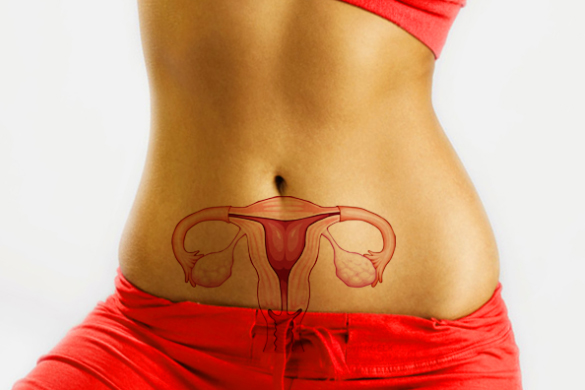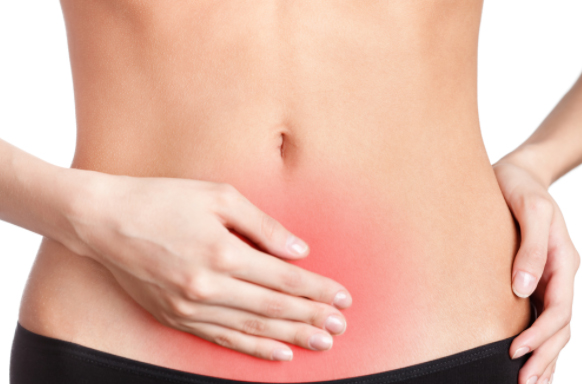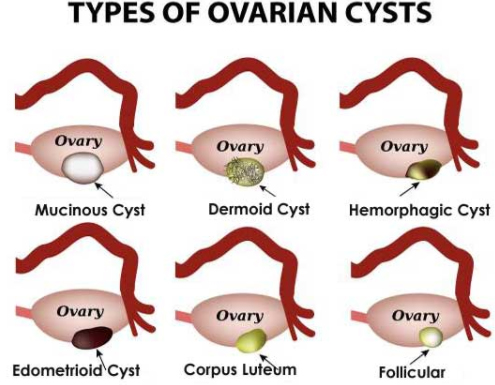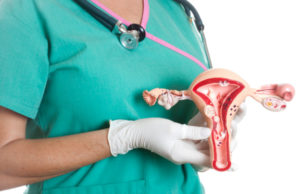
Here we discuss one of the main female health issues – Postpartum Ovarian Cysts and Symptoms of ovarian cysts . Also different ovarian cyst treatment
Every woman develop cysts at least once in her lifetime. A ovarian cyst is a fluid filled sac which forms inside the ovary / female reproductive system. Not all cysts are painful though most of them cause symptoms such as pain during sex, nausea, irregular menstrual cycles, bloating, painful bowel moments and pain in the lower abdomen. Here we will discuss about Postpartum Ovarian Cysts
Anatomy and physiology of ovary
Ovaries also known as female gonad are a pair of female reproductive glands located on either side of the uterus in the pelvis. The ovary is of a size of a walnut. The main function of ovary is to produce ova and also release the female hormones estrogen and progesterone. Ovary being the main source of female hormones is responsible for the various feminine characteristics like the breasts, body shape, and the female pattern of hair distribution. The pregnancy and menstrual cycle is also regulated by the ovaries.
Read Also : Breast Sagging – Things that every women must know
Pathophysiology of Ovarian cyst
Ovarian cysts are generally small sac within the ovary. They might be filled with liquid or any semi solid substance. It may or may not be cancerous. Most of the times the ovarian cyst are benign.
Each month in a normal female with proper functioning ovaries there is development of small follicles called as Graafian follicles. During the mid cycle the dominant follicle among them releases a mature oocyte. This ruptures and forms the corpus luteum. If the mature oocyte does not undergo fertilization then it undergoes fibrosis and gradually shrinks. If fertilization takes place then the corpus luteum slowly increases in size and decreases during pregnancy. The cysts that arise due to the normal ovarian function are called functional cysts and are benign. These could be follicular or luteal cysts. In cases of infertility, the ovulation inducing agents like FSH, HCG, clomiphene citrate may cause over stimulation and cause cysts.
Ovarian cysts occur at any age and the incidence is more during reproductive age. Cyst after child birth are also increasing and are seen more commonly in those following Postpartum birth control methods. As the lady undergoes menopause the chances of getting ovarian cyst also decreases.
Read Also : Hormonal Imbalance Signs and Treatment in Men & Women
Types of Ovarian Cysts
Not all ovarian cyst are dangerous but there are dangerous ovarian cysts also . Ovarian cyst and cancer is a common topic that is discussed so far . But as we said some ovarian cis will be leading to ovarian cyst cancer.
There are different types of Ovarian Cyst –
- Ovarian endometriomas /endometrioma chocolate cyst
This endometrioma chocolate cyst increases the risk of ovarian cancer in women .
- Ovarian cystadenomas
This ovarian cyst can also turn into cancerous cyst in ovary.
- Ovarian dermoid cysts
This cyst doesn’t go away on its own , it is mostly treated with surgery only.
Postpartum is a crucial phase in a woman’s life. The changes the body and especially the reproductive organs go through and the hormones and their effects can create anxiety. Maintaining good Postpartum health is very important. The chances of cyst after child birth are equally high. These could be due to a variety of reasons. The Postpartum birth control pills are also attributed as a reason for the Postpartum Ovarian Cysts .
Read Also : Menstrual Cups, a solution to the pad effect-Another Period
Vaginal cyst, ovarian cyst after delivery and ovarian cyst during breast feeding are commonly seen post child birth and mostly are silent. They just go unnoticed and are symptom-less unless complications arise.
Read Also : Cancer fighting meal plan to healthy life – Cancer Types, Symptoms
Read Also : Cancer Preventing Ketogenic Diet Plans
Read Also : Best Pre-existing Cancer Health Insurance For different Countries
Signs and symptoms of Postpartum Ovarian Cysts
Postpartum health is crucial for development of vaginal cyst as we as ovarian cyst. Most of the time ovarian cyst after delivery or the ovarian cyst during breast feeding goes unnoticed unless they undergo complications. The ovarian cysts do not produce any symptoms. They are just an incidental finding during pelvic examination or an ultrasound that is done for some other reason. The patient may present with symptoms if it is a large cyst or a ruptured cyst. Larger the cysts more are the symptoms due to the size of the cyst, pressure symptoms, as well as due to the distortion of the surrounding anatomical structures.
Read Also : Weight Loss Diet plan for Different Age & Different diet methods
Cysts on Ovaries Symptoms
If you are worrying about whether you have cysts on ovaries symptoms of such cases of Ovarian Symptoms includes
- Bloating or abdominal fullness.
- Lower back pain
- Early satiety even after ingestion of a small quantity of food
- Increased urinary frequency as well as pain while passing urine.
- Constipation as well as altered bowel movements
- Painful sexual intercourse
- Delayed ad irregular menstrual periods.
In some cases the cysts undergoes torsion or breaks open. In such cases of cyst rupture the patient complains of:
- Excruciating sudden abdominal pain accompanied with nausea and vomiting
- Sharp pain during or after sex
Ruptured cysts bleed profusely which requires immediate medical attention to prevent the complications of severe bleeding.
Read Also : Water Fasting Benefiting conditions and Risky Water Fast
Diagnosis of ovarian cyst
Most of the times the diagnosis of ovarian cyst is incidental finding but in cases of complicated cyst it is the leading diagnosis. A gynecologist while examining the pelvis by bimanual method grabs the diagnosis of ovarian cyst. If the patient has classical symptoms, then imaging techniques give the diagnosis of ovarian cyst. Ultrasound is the diagnostic modality to diagnose ovarian cyst. Transvaginal ultrasound gives a clearer picture of the ovaries by passing a probe inside the vagina. CT scan or MRI scan also help in diagnosing ovarian cyst.
Though cancer of the ovaries is a very rare entity, it is essential to rule out ovarian cancer in all patients above the age of 40 years. CA-125, a serum marker gives a clue to the diagnosis of ovarian cancer. But in all cases it does not depict cancer. It is not a specific test and will be elevated even in normal women of child bearing age.
Read Also : Prevent Wrinkle on Skin with these Magic Rules
Treatment of Postpartum Ovarian Cysts
Ovarian cyst treatment is not always ovarian cancer treatment , there are different ways of ovarian cyst treatment –
Medical management
Ovarian cyst after delivery or the ovarian cysts during breast feeding are generally of follicular type or corpus luteum cyst. These generally regress in size and gradually disappear in one to three months. The chances of rupture are also present with these cysts. The advantage of these cysts is that they are benign and do not cause medical issues over a longer period of time. Most of the time these cysts go unnoticed and can be an incidental finding during pelvic or radiological imaging. Postpartum birth control pills helps in stopping the ovulation process. Thus the emergence of new cyst formation is prevented.
Ultrasound gives a clue if it is a simple or complex cyst. A simple cyst will have only fluid without any tissue whereas a complex cyst has solid components. The complex cyst requires surgical excision. For pain, a pain killer can be useful.
To summarize, treatment of ovarian cysts is a multi factorial decision. Most of the times the ovarian cysts that occur during breast feeding or after delivery need no treatment. Depending on the size of the cysts, the pressure symptoms caused, age of the patient and the ultrasound findings treatment modality can be determined. Cysts that are functional are only observed without any treatment. They need frequent close up monitoring to watch for signs of torsion or rupture. If they undergo torsion or rupture causing severe bleeding then surgery is the mainstay of treatment to prevent further blood loss. Benign and malignant tumors have to be excised by surgery. If it is a malignant tumor, then surgery is the option to remove it followed by anti cancer treatment.
Note – Even there are home remedies for ovarian cysts treatment but i think personally it is not the right solution for cyst .
Surgery for ovarian cyst
For surgical removal either laparotomy or laparoscopy can be done. The cyst that is removed is sent to histopathological examination to give the final diagnosis of the type and nature of the cyst.
Prognosis of Postpartum Ovarian Cysts
Most functional or Postpartum Ovarian Cysts are self limiting. They resolve by its own and do not cause any long term complications. The prognosis of ovarian cancer depends on the stage of the disease, and extent of spread.
Postpartum Ovarian Cysts in most of the cases are silent cysts without any problems. Seeking a gynecologist help when there is suspicion of ovarian cyst is required to prevent any future complications. Ovarian cyst after delivery or the ovarian cysts during breast feeding are self limiting.

















0 comments